 Sun and Sky
Sun and Sky
The Sun and Sky are closely related to each other. The Sun can change the brightness of the Sky in Automode. If the Sun is on and the Sky is an HDRI balancing their strengths is important.
Sun
The Sun is a powerful invisible parallel light. Factors simulating real-world conditions such as latitude and longitude, time of day, and season control the Sun’s direction and brightness.
This help topic reviews the Flamingo Sun control. The Rhinoceros Sun control may also be used to place the sun. Flamingo will keep the two sun controls in sync.
Where can I find Flamingo Sun control?
The Sun must be activated through the Lighting Preset or the Custom Lighting settings.
 Toolbars >
Toolbars > Flamingo nXt Toolbar
Flamingo nXt Toolbar Menus > Flamingo nXt 5.0 Pulldown > Show Control Panel > Flamingo nXt Tab > Sun
Menus > Flamingo nXt 5.0 Pulldown > Show Control Panel > Flamingo nXt Tab > Sun
Note: The Sun tab will only be visible if the Sun is activated through a Lighting Preset.
Solar angles are required to perform sunlight calculations. There are two ways to specify the sun direction: by date, time, and place; and by direct angle. Use date, time, and place positioning to simulate the real sun in a study of your model’s site. Direct sun angle controls the light angle without reference to a real sun. Use the direct sun angle to try lighting effects.
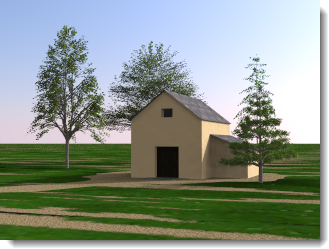
 Sydney, Australia, 21-June, 09:30 (on the left). Stockholm, Sweden, 21-June, 09:30 (on the right).
Sydney, Australia, 21-June, 09:30 (on the left). Stockholm, Sweden, 21-June, 09:30 (on the right).
Set azimuth and altitude
Use solar angles to manually set the sun’s direction. Enables Azimuth and Altitude controls.
Azimuth
Sets the sun’s direction in angle degrees from North (0) in the horizontal plane. The circular map shows the world in a plan view.
Altitude
Sets the sun’s height in the sky in angle degrees from the Equator (0). The half circle map simulates a section through the vertical direction of the world coordinates.
Set location on Earth
Use the sun angle calculator to place the sun based on Date, Time, Location. Note: As with all Sun calculators, the Sun position accuracy may vary. If absolute accuracy is required it is recommended to verify the sun location.
Date
Specifies the date.
Time
Specifies the local time of day.
Daylight savings time
Sets the time forward by one hour.
Latitude/Longitude
Enter a latitude and longitude or pick a location on the map. The numbers will also update to display the latitude and longitude of a location picked on the map with the mouse cursor.
Time zone
Displays the time zone based on Latitude and Longitude for the current location.
City list
Use this to select a major city to set the location.
Map
Click the map to specify a location. Drag with the left mouse button to pan the map.
Sun intensity
Modifies the brightness of the sun (direct) daylight component. The intensity of sun is automatically calculated based on solar angles and sky conditions, but can be modified to balance with other lights.
Sun highlight
The sharpness of the sun highlight.
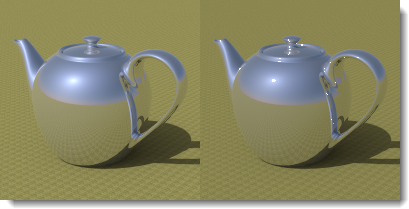 Sun highlight=0 (left) and 1 (right).
Sun highlight=0 (left) and 1 (right).
Note: Solar highlight artifacts can sometimes be seen on exterior renderings when the Sun highlight setting is used. To mitigate or eliminate this artifact, set the Sun highlight to a smaller value.
Sun channel
Specify the lighting channel the Sun will render to. It is very useful to place the Sun on a specific channel when trying to balance the sun strength with other light sources. The default channel is 0. Rendering to a channel will allow the strength of the sunlight to be quickly adjusted after a rendering without the need to rerender.
North Direction
Note: North is the World Y direction.
Sky
The Sky is a large sphere around the rendering that can be used for lighting. The Sky is very different from environment. Sky controls lighting. Environment controls what is reflected and visible in the background. There are many situations where the Sky and Environment might be set differently.
Where can I find Flamingo Sky control?
The Sky must be activated through the Lighting Preset or the Custom Lighting settings.
 Toolbars >
Toolbars > Flamingo nXt Toolbar
Flamingo nXt Toolbar Menus > Flamingo nXt 5.0 Pulldown > Show Control Panel > Flamingo nXt Tab > Sky
Menus > Flamingo nXt 5.0 Pulldown > Show Control Panel > Flamingo nXt Tab > Sky
The lighting preset schemes for Exterior and Interior daylight use the Automatic sky by default. The Studio lighting preset scheme uses HDR image lighting by default.
Sky can be set five ways:
The two best settings for sky lighting types are HDR image sky and Automatic sky. HDR image sky uses an image with lighting values stored on each pixel to provide light and reflection. Automatic sky uses a real-world sun location and cloudiness to simulate a sky. These settings will produce the most dynamic renderings.
Automatic Sky
Automatic sky uses settings from the Sun tab to specify the color range and intensity of the skylight. For instance, when the sun is high in the sky, the lighting and colors of the sky are very different than when the sun is low in the sky.
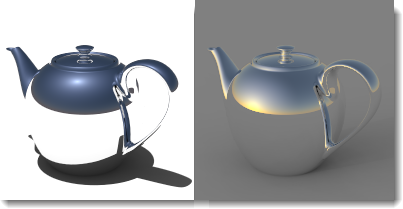 Automatic sky: sun high (left) and low (right) in the sky.
Automatic sky: sun high (left) and low (right) in the sky.
Cloudiness
When Cloudiness is turned off, the sky is considered clear and strong shadows are created. The greater the cloudiness, the less contrast there will be between the light and shadows. Greater cloudiness will create lighter shadows and a more even lighting effect. The Cloudiness setting affects many aspects of the daylight calculation, including the relative amounts of direct vs. indirect lighting, the way indirect lighting is calculated, and the background color if Automatic Sky mode has been selected. The Cloudiness setting varies from 0 (clear) to 1 (completely overcast). The cloudiness settings around 0.35 - 0.50 is a very sensitive and dynamic range.
 Cloudiness 0 (left) and 1 (right).
Cloudiness 0 (left) and 1 (right).
Sky intensity
Modifies the brightness of the sky (indirect) daylight component. The intensity of skylight is automatically calculated based on solar angles and sky conditions, but can be modified. Note: This setting only matters if there are other lights in the scene that have to be compensated for. If there are no other lights, the tone operator will compensate the exposure and the rendered image will not be brighter or dimmer based on this setting.
Sky channel
Specify the lighting channel the Sky will render to. It is very useful to place the Sky on a specific channel when trying to balance the sky strength with other light sources. The default channel is 0. Rendering to a channel will allow the strength of the skylight to be quickly adjusted after a rendering without the need to rerender.
High-Dynamic-Range Image Sky
A high-dynamic-range (HDR or HDRI) image is a special 2-D image file. These images contain a much broader range of values at each pixel then standard image files, such as a .jpg or .png. This extra data can be used to light models. If the values contained in the HDR are accurate, then the lighting will be accurate. This can produce very dynamic lighting in a scene. The preset Studio Lighting scheme uses HDR images for the sky. If you are thinking of studio lighting as an indoor activity, think of the HDR image as a ceiling that emits light based on the colors in the image.
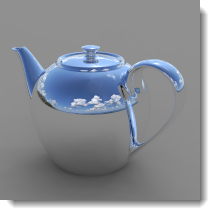 HDRi lighting.
HDRi lighting.
It is assumed that HDR images contain radiance values expressed in watts units. If this is not the case, the intensity of these HDR images may need to be adjusted in order to achieve proper illumination levels.
In addition to the Sky, a different HDR image can be used for each of the three visible backgrounds: Visible, Reflected, and Refracted background.
HDRI Image
Specifies the HDR (HDR and HDRI are the same file type) image file. Click on the image to select a different HDRI.
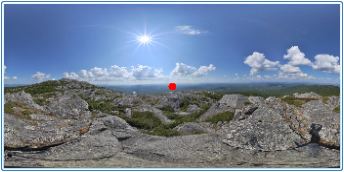 Equirectangular projection.
Equirectangular projection.
HDR images come in two projection types which let the image to properly wrap around the sky sphere. The most popular is equirectangular. These images are rectangular with an aspect ratio of 2:1. Equirectangular images will have similar resolution over the whole image. The second projection is spherical. Spherical HDRI images are square in aspect ratio and the image will show great curvature. Spherical projections have less resolution at the seam.
Intensity
Modifies the brightness of the HDR image light. This setting only matters if there are other lights in the scene that have to be compensated for. If there are no other lights, the tone operator will compensate the exposure and the rendered image will not be brighter or dimmer based on this setting.
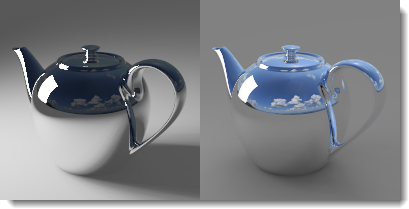 Low and high HDR intensity.
Low and high HDR intensity.
Plan control
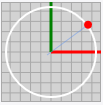
- Click on the plan control to rotate the HDRI correctly.
- The red dot signifies the center of the HDRI image.
Rotation
Rotates the image so a different part of the image lights the model.
{: .inline} In the illustration, the image has been rotated so the reflection of the sun appears on the object. Enter rotation degrees or interactively move the rotation widget indicator.
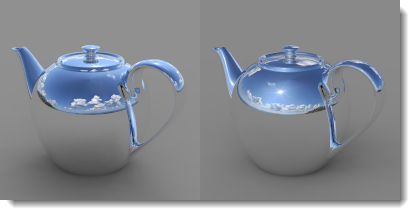 Image rotated so the sun appears on the object.
Image rotated so the sun appears on the object.
Saturation
The color saturation for the light. Since the light from an HDR image is the color of the pixels in the image, this sometimes produces unwanted color effects. Set the saturation low if you want the light from the image, but not the color.
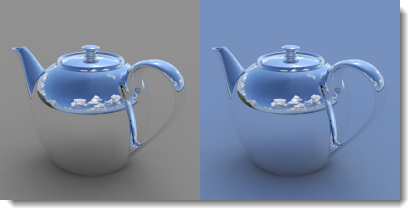 Low (left) and high (right) saturation.
Low (left) and high (right) saturation.
Mirror
Reverses the image from left to right.
Sky channel
Specify the lighting channel the Sky will render to. It is very useful to place the Sky on a specific channel when trying to balance the sky strength with other light sources. The default channel is 0. Rendering to a channel will allow the strength of the skylight to be quickly adjusted after a rendering without the need to rerender.
Color
It is possible to use a color or gradient of color to light the scene. The colors in the sky are multiplied by the intensity value to give the colors a lighting value.
Intensity
The Intensity value is used to multiply the colors in the Sky and result in a lighting value. Colors can range from 0 - 256 per channel. Intensity will multiply those values.
Color type
There are three ways to control the color of the sky. These are similar to the Color Environment controls. See Color Background controls for more information.
Image
It is possible to use an image to light the scene. The colors in the image are multiplied by the intensity value to give the colors a lighting value.
Intensity
The Intensity value is used to multiply the colors in the Sky and result in a lighting value. Colors can range from 0 - 256 per channel. Intensity will multiply those values.
Image Projection
There are many ways to control how an image is mapped to the sky. These are similar to the Image Background controls. See Image Background controls for more information.